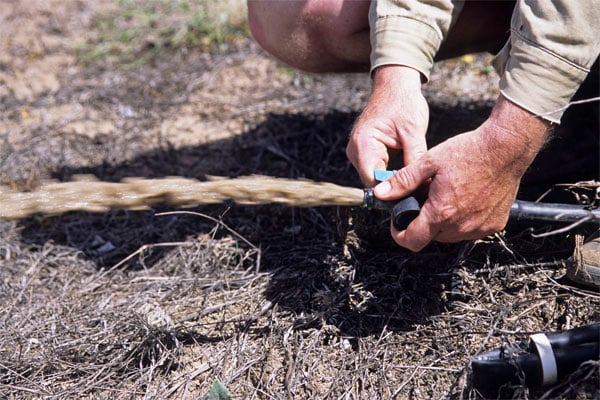Irrigation systems only operate well if properly maintained. This is especially important for drip irrigation, as it is difficult to detect problems before crop health problems become obvious.
The most common problems with drip irrigation are:
- emitter clogging
- dripper component deterioration
- system pressure mismanagement.
Regular maintenance and monitoring is the best way to identify and avoid problems before crop health and yield suffers.
Over time, system performance will decline to some degree in all drip systems, regardless of management. However, there are ways to minimise this decline.
Systems that are regularly flushed, cleaned, have adequate filtration and are initially well designed (including the ability to adequately flush) can maintain an acceptable level of performance over an extended period.
The three main areas of drip system maintenance are:
- Flushing
- chlorine or hydrogen peroxide injection (oxidation)
- acid injection
Flushing the system
Even with a good filtration system, emitter blockages can occur. It is therefore important to regularly flush mains, submains and laterals (as well as filters). Most filtration systems are designed to stop material greater than 130 micron entering the system. Silt and clay particles are much smaller than this and can build up within the system.
It is recommended that the system is given a complete flush before the first irrigation of the season, several times during, and again at the end of the season.
Oxidation
Oxidation is carried out to reduce blockages due to organic matter. Chemicals such as chlorine and hydrogen peroxide are oxidising agents that kill bacteria, algae and other organic matter.
Chlorine is the most common product used for oxidation and treatment can be intermittent (injecting chlorine periodically) or continuous (injecting small amounts every irrigation).
Hydrogen peroxide is a relatively new product to Australia and its use is gaining in popularity. It is much more corrosive than chlorine and therefore safety procedures need to be followed. Unlike chlorine, it is effective at high water pH and often preferred by organic farmers.
Acid injection
While chlorine is used to manage organic deposits, acids can be injected to control mineral deposits. Dissolved impurities such as calcium and iron in the irrigation water can form solids in the drip system. If this problem has occurred, calcium salts can appear as a white film on the inner surface of the system. These impurities can be dissolved by lowering the pH of the water, by injecting dilute solutions of acid such as hydrochloric, sulphuric, citric or phosphoric acid.
Using acid can be hazardous and many irrigators are engaging qualified contractors to carry-out acid injections.
Systems that are regularly flushed, cleaned, have adequate filtration and are well designed (including the ability to adequately flush) can maintain an acceptable level of performance over an extended period.

